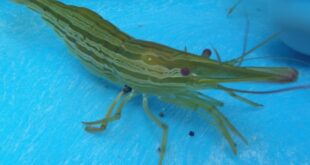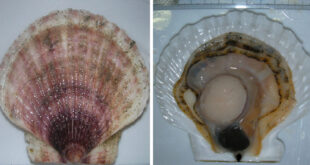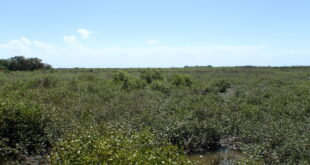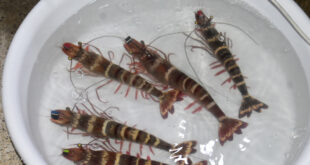By Development Communication Section

Over a hundred fish farmers and other stakeholders availed of free lectures and consultations on 11 July 2018 at SEAFDEC/AQD’S Multi-Purpose Hall in Tigbauan, Iloilo as part of the annual Farmers’ Forum and Aquaculture Clinic.
Aimed at providing the public with aquaculture updates, SEAFDEC/AQD specialists shared developments on aquaculture feeds made from locally available ingredients, giant freshwater prawn farming, shrimp farming, and tilapia breeding and farming.
In the aquaculture clinic that followed the lectures, stakeholders also had the opportunity to consult various SEAFDEC/AQD specialists regarding their specific concerns including problems in farming and opportunities for investment.
The activities were organized as part of the events commemorating SEAFDEC/AQD’s 45th founding anniversary.
Cost-effective aquaculture feeds made from locally available ingredients
To promote the use of cost-effective aquaculture feeds, SEAFDEC/AQD feed nutrition scientist Dr. Roger Edward Mamauag shared different alternative protein sources for fish feeds. Protein is usually sourced from fish meal but feeding captured fish to farmed fish is considered an unsustainable practice.
Dr. Mamauag revealed that processed meal from knife fish can replace the common fishmeal ingredient up to a 43% inclusion level in juvenile tilapia diets. Knife fish is considered as a pest in Laguna de Bay, the largest lake in the Philippines.
Protein-enhanced copra meal was also found to be able to replace fishmeal by up to 40% as ingredient in shrimp diets. In milkfish diets, the fermented copra meal can be added up to 25% inclusion level, partially replacing soybean meal. Copra meal is a byproduct in the production of coconut oil.
The use of some plant-protein sources, including agricultural wastes, in tilapia diets was reported to also contribute to improved production traits.
One such agricultural waste is mango peel silage which contains 39.72-42.38% crude protein and is heavily concentrated with carotenoids which are important for fish reproduction.
Soybean curd was also tested to successfully replace up to 45% of fish meal in aquafeeds. Citrus peel and citrus pulp on the other hand, can be added for up to 50% and 10%, respectively.
Aside from reducing the use of fish oil and fish meal, Dr. Mamauag stressed the importance of ensuring the efficient conversion of nutrient inputs and the use of technologies that are environmentally sensible and sustainable.
Giant freshwater prawn farming
Giant freshwater prawn, Macrobrachium rosenbergii, is gaining popularity as an aquaculture species as reflected in the increase in worldwide production from about 30,000 tons in 1990 to about 200,000 tons in 2010.
In her presentation, SEAFDEC/AQD scientist Dr. Maria Lourdes Aralar narrated the culture protocols in the culture of the prawn from broodstock management, hatchery design, requirements for larval rearing, water management, feeding schedule, nursery system, and the different grow-out systems.
One of the tips mentioned by Dr. Aralar in grow-out culture is to size-grade the postlarvae before stocking. Size grading results in more uniform growth and reduces percentage of small-sized prawns at harvest.
In feeding, Dr. Aralar suggested to use feeding trays to monitor feed consumption and to reduce feeding rate by 50% if oxygen fall below 3.5 ppm in early morning and temperature falls to 20-24 degrees Celsius during the day.
Dr. Aralar also presented sample growth parameters in lake-based culture using batch system with a stocking density of 10-15 pieces per square meter. With a culture duration of five months, daily growth rate is 0.17-0.22 gram per day leading to an average weight at harvest of 25-35 grams and a feed conversion ratio of 1.8-2.2.
Shrimp farming
With SEAFDEC/AQD’s current thrust on reviving the tiger shrimp industry or “Oplan Balik Sugpo,” shrimp pond culture expert Mr. Victor Emmanuel Estilo presented different strategies to avoid disease occurrences.
Mr. Estilo listed the basic facilities required to ensure biosecurity in shrimp farms such as hand wash/foot bath stations, tire baths stations, bird scare devices, water filters and crab fences.
Other proactive strategies to avoid diseases include the use of high health, specific-pathogen-free postlarvae, probiotics, minimum to zero water exchange systems, and the conduct of regular disease surveillance and monitoring.
Also recommended were the use of reservoirs or underground water sources, HDPE-lined ponds, automatic feeders, sludge removal facilities and smaller pond compartments.
Farmers should focus on “animal comfort,” said Mr. Estilo, and time culture periods with seasons of higher average temperatures and less rain, to keep shrimp robust and minimize the occurrence of diseases.
Tilapia breeding and farming
Dr. Maria Rowena Eguia, a scientist at SEAFDEC/AQD, revealed that four out of the top ten tilapia-producing countries in the world are from Southeast Asia, namely Indonesia, Philippines, Viet Nam and Thailand where it is a popular aquaculture species since it breeds easily, grows fast and adapts to a wide range of environmental conditions.
Dr. Eguia added that tilapia involves a simple hatchery and nursery technology, enjoys wide consumer acceptance, and is used as a bio-control agent for luminous bacteria in shrimp ponds in the Philippines.
After sharing the basics of tilapia culture, Dr. Eguia also mentioned the use of netting materials called “Aquashade” which can reduce pond heat by 40% and double the spawning rate and seed production of a tilapia farm during extremely warm summer months.
Dr. Eguia also outlined the research work being done by SEAFDEC/AQD for tilapia such as the genetic improvement of performance traits, DNA marker assessment of improved strains, and marker-aided broodstock management.

 SEAFDEC/AQD Southeast Asian Fisheries Development Center | Aquaculture Department
SEAFDEC/AQD Southeast Asian Fisheries Development Center | Aquaculture Department



